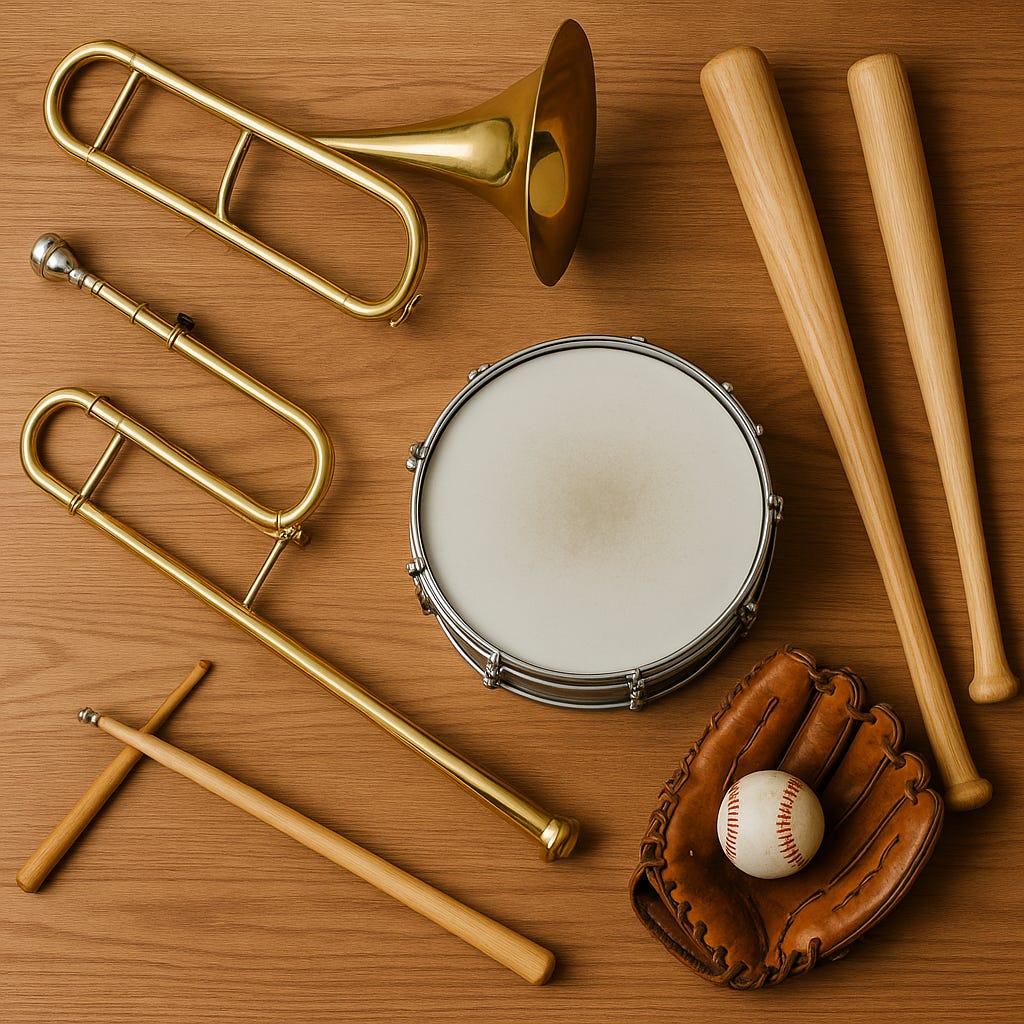My Oldest Friend Sent Me an Article About the Word “Jazz”
[That is one strange-looking, jazzed-up trombone! Perfect for this story.]
My Oldest Friend Sent Me an Article About the Word “Jazz”
By Jim Reynolds | www.reynolds.com
Grook for the Jazz Story
A word once pitched,
a ball once thrown,
a rhythm caught,
a style grown.
From field to band,
from rag to swing,
junk or curve —
it’s jazz, the thing.
Note: After a tough political week, I wanted to share something lighter. My old high school friend Mike — my roommate at UCSB, drummer in our first band, and fellow Grook-lover — sent me an article on the word jazz. He knew it would hit both of my old loves: music and baseball. It inspired me to write him back. What follows is my note to him — part memory, part improvisation, part curveball.
The Origins of “Jazz”
The word jazz didn’t begin in music—it started in sports. In the 1910s, sportswriters used it to describe energy, strategy shifts, and lively pitches like curveballs. Pitcher Ben Henderson even dubbed his curve “the Jazz ball” in a 1912 interview with the Los Angeles Times. Within a few years, the term was showing up in baseball columns and pep talks about crowd spirit and team fight.
The roots go back further: a mid-19th century slang term “jasm” meant drive or energy. It showed up in an 1860 novel and eventually morphed into jazz. By 1915, newspapers in Chicago were applying it to a new music style blending blues and ragtime. Black musicians who pioneered the sound often disliked the label — Sidney Bechet called it “a name the white people have given to the music” — but the term stuck. By the 1920s, it had spread beyond music to describe a cultural mood, as in F. Scott Fitzgerald’s Tales of the Jazz Age.
Over time, jazz narrowed back to its musical core, coming to mean the improvisational, syncopated style of artists like Miles Davis. Some, like Max Roach, objected to the term as exploitative, while others embraced it. Beyond music, jazzalso lives on as a verb — “to jazz something up” — still tied to its original sense of liveliness and spark.
The above summary was adapted from this article: Baseball and the Origins of Jazz.
My Note to Mike
Mike,
I hope your kidney stones are doing ok. Never had those, and all that jazz.
Musically, the jazz idea has more to do with swing — swing 8ths, for you drummer types. [Mike is a drummer. We had a band in high school called Papa Goza’s Weasels — led by Eric Goza, who claimed to be a member of Mensa.] Scott Joplin did plenty of syncopation in an earlier era, but he never swung his 8th notes. Just think of The Maple Leaf Rag — straight 8ths.
By the 1920s, swing 8ths were the thing. Dance music lived and breathed on that rhythm, and it stayed that way for decades, outside of Latin music.
But jazz in a baseball context? I can see that. Something a little off key, out of bounds, adventuresome — like a screwball or a knuckleball. Elroy Face throwing a forkball. Sure enough, later we called those pitches “junk.” Anything that didn’t go straight was junk — a close relative to the earlier “jazz.”
Jerry [my brother] and I developed a whole repertoire of junk pitches in our whiffle ball battles. This was before they put holes in the plastic balls. We used the side of the garage as a backstop and strike zone, home runs flying into the neighbors’ front yard across the sreet. I learned to throw curves that bent five feet, screwballs that darted the other way, even a fastball that rose and a knuckleball that dropped off the table. That was pure jazz from the riffing Reynolds boys.
As a kid, I was one of the better pitchers around. All-city champ in Downey at 11, multiple no-hitters in Mojave Little League, solid in Greenfield Baseball Association by 8th grade. I once struck out 10 in three innings against Pixley’s all-stars. I looked forward to high school ball.
Then it all stopped.
After basketball season, I came out for freshman baseball and found the team already set. Coach Ward wasn’t interested. Never gave me a chance to throw a single pitch, even against guys I had dominated before. Sophomore year, budget cuts killed non-varsity sports. Junior year, Nyquist — our orchestra director turned baseball coach — barely looked at me. I got a brief outing against the varsity, did fine, but that was that.
Ironically, our senior team’s biggest weakness was pitching. They even relied on a freshman “phenom” to win the big games. The poor kid had talent, but he died in a car accident not long after. What a loss.
Looking back, I believe I could have made a difference. I had good speed, good control, plenty of junk pitches, and a drive to compete. But by then, my priorities had shifted. I was already looking past high school. So I didn’t even try out.
In the end, it doesn’t matter much. But it’s fun to talk about.
Sixty years gone, and the memories still swing. That’s jazz — in music, in sports, and in life.
Let the Weasels play on.
Regards,
Jim Reynolds




If only they had the NIL system when we were in high school. Might’ve been a different outcome for us playing college ball.